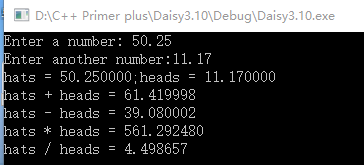C++学习(七)入门篇——C++算数运算符
以下介绍5种C++基本运算符
+、-、×、/、%
注意/为第一个数除以第二个数,结果为商的整数部分,小数部分被丢弃
%求模,两个操作数必须是整型,它生成第一个数除以第二个数的余数
如果其中一个是负数,那么结果的符号满足:(a/b)*b+a%b=a
程序清单3.10 arith.cpp
//arith.cpp - - some C++ arithmetic
#include<iostream>
int main()
{
using namespace std;
float hats, heads;
cout.setf(ios_base::fixed, ios_base::floatfield);
cout << "Enter a number: ";
cin >> hats;
cout << "Enter another number:";
cin >> heads;
cin.get();
cout << "hats = " << hats << ";heads = " << heads << endl;
cout << "hats + heads = " << hats + heads << endl;
cout << "hats - heads = " << hats - heads << endl;
cout << "hats * heads = " << hats * heads << endl;
cout << "hats / heads = " << hats / heads << endl;
cin.get();
}
得到输出:

11.17+50.25=61.42,输出为61.41998,这不是运算问题,而是float表示有效位数能力有限。
它只保证6位有效位,四舍五入成6位就是61.4200是对的,cout打印6个小数,使用double能保证更好的精度。
1.运算符优先级和结合性
先乘除后加减,也可以用括号来执行自己定义的优先级
而×、/、%优先级相同,这个时候需要考虑结合性,可去附录D查看
如float logs=120/4*5;
乘除都是从左到右的,所以结果为150
仅当两个运算符被用于同一操作数时,优先级和结合性规则才有效
如int dues=20*5+24*6;
程序清单3.11 divide.cpp
//divide.cpp - - integer and floating-point division
#include<iostream>
int main()
{
using namespace std;
cout.setf(ios_base::fixed, ios_base::floatfield);
cout << "Integer division: 9/5 = " << 9 / 5 << endl;
cout << "Floating-point division: 9.0/5.0 = " << 9.0 / 5.0 << endl;
cout << "Mixed division: 9.0/5 = " << 9.0 / 5 << endl;
cout << "double constants: 1e7/9.0 = " << 1e7f / 9.0 << endl; //1.e7f也可以
cout << "float constants: 1e7f/9.0f = " << 1e7f/ 9.0f << endl;
cin.get();
}

浮点常量在默认情况下为double类型,两操作数为float则结果为float,一个double,一个float也为double
运算符重载是什么意思?
比如你定义一个类型“学生”
现在如果你把两个“学生”类型的变量相加, 那系统怎么知道你要怎么加? 如果是数字的话,系统知道。
那这个时候,你就要为“学生”这个类型重载加号运算符
然后在这个重载的方法里实现相加的意义,比如“学生”类型的年龄相加,或是其它东西相加,这个就你自己定义了
2.求模运算符
它返回整数除法的余数,适用于解决要求将一个量分成不同整数单元的问题
程序清单3.12 modulus.cpp
//modulus.cpp - - uses % operator to convert lbs to stone
#include<iostream>
int main()
{
using namespace std;
const int Lbs_per_stn = 14;
int lbs;
cout << "Enter your weight in pounds:";
cin >> lbs;
cin.get();
int stone = lbs / Lbs_per_stn;
int pounds = lbs%Lbs_per_stn;
cout << lbs << " pounds are " << stone << " stone," << pounds << " pounds\n";
cin.get();
}
得到结果:

3.类型转换
C++允许将一种类型的值赋给另一个类型的变量
so_long = thirty;
程序将thirty的值扩展为long,扩展后得到一个新值,被存储在so_long中,而thirty内容不变。值不会改变,只是占用更多的字节。
| 将较大的浮点类型转换为较小的浮点类型,如将double转换为float | 精度(有效位数)降低,值可能超出目标类型的取值范围,在这种情况下,结果将是不确定的 |
| 将浮点类型转换为整型 | 小数部分丢失,原来的值可能超出目标类型的取值范围,在这种情况下,结果将是不确定的 |
| 将较大的整型转换为较小的整型,如将long转换为short | 原来的值可能超出目标类型的取值范围,通常只复制右边的字节 |
像一个long值,(如2111222333)赋给float精度将下降,float只有6位有效数字,四舍五入为2.11122E9
将浮点转化为整型会将数字截短,其次float相对于int太大了,float至少32位,int至少16位。
程序清单3.13 assign.cpp
//init.cpp - - type changes on initialization
#include<iostream>
int main()
{
using namespace std;
cout.setf(ios_base::fixed, ios_base::floatfield);
float tree = 3;
int guess(3.9832);
int debt = 7.2E12;
cout << "tree = " << tree << endl;
cout << "guess = " << guess << endl;
cout << "debt = " << debt << endl;
cin.get();
}
得到输出:

int变量无法存储3.0E12,导致C++没有对结果进行定义的情况发生。
使用大括号的初始化称为列表初始化,给复杂的数据类型提供值列表。它对类型的转换要求更加严格,列表初始化不允许缩窄。即变量的类型无法表示赋给它的值。
条件是编译器知道目标变量能够正确的存储赋给它的值。
const int code=66;
int x =66;
char c1 {31325}; 缩窄
char c2 = {66};
char c3 = {code};
char c4 = {x}; x是一个变量,编译器不会跟踪从x被初始化到它被用来初始化c4
x=31325;
char c5 = x; 允许
自动转换:
在计算表达式时,C++将bool、char、unsigned char和short值转换为int叫做整型提升,当运算涉及两种类型时,较小的类型被转化为较大的类型。
(1)如果有一个操作数类型为long double,则将另一个转换为long double
(2)否则,有一个类型为double,则将另一个转化为double
(3)否则,一个类型为float,则另一个为float
(4)否则,操作数都是整型,因此执行整型提升
(5)如果两操作数都是有符号或无符号的,且其中一个操作数比另一个低,则转换为高的级别
(6)如果一个有符号,一个无符号,无符号操作数比有符号的高,则将有符号转化为无符号的类型
(7)如果有符号类型可表示无符号的所有可能取值,则将无符号转化为有符号操作数所属类型
(8)否则,将两个操作数都转化为有符号类型的无符号版本
有符号整型按级别从高到底:long long、long、int、short和signed char。无符号整型和有符号整型排列顺序相同。类型char、signed char和unsigned char相同,类型bool级别最低,wchar_t、char16_t、char32_t级别和底层类型相同。
强制类型转化(将thorn中的int值转化为long类型)
(long) thorn
long (thorn)
强制类型通用格式
(typeName) value
typeName (value)
第一种格式来自C语言,第二种格式是C++,就像是函数调用。
C++还引入了四个强制类型转换符,static cast<>通用格式
static_cast<typeName> (value)
程序清单3.14 typecast.cpp
//typecast.cpp - - forcing type changes
#include<iostream>
int main()
{
using namespace std;
int auks, bats, coots;
auks = 19.99 + 11.99;
bats = (int)19.99 + (int)11.99;
coots = int(19.99) + int(11.99);
cout << "auks = " << auks << ",bats = " << bats;
cout << ",coots = " << coots << endl;
char ch = 'Z';
cout << "The code for " << ch << "is ";
cout << int(ch) << endl;
cout << "Yes,the code is ";
cout << static_cast<int>(ch) << endl;
cin.get();
}
结果:

auto这个新工具能够根据初始值的类型来推断变量的类型
auto n=100; int
auto x=1.5; double
auto y=1.3e12L; long double
但也会导致问题
如要把x、y、z指定为double类型
auto x=0.0;
double y=0;
auto z=0; 可知z是int类型



